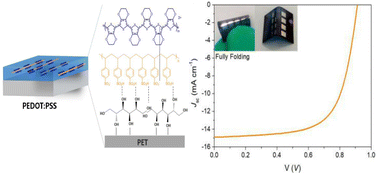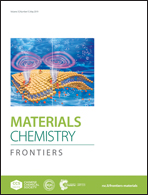High-efficiency robust organic solar cells using transfer-printed PEDOT:PSS electrodes through interface bonding engineering†
Abstract
The development of high-efficiency, flexible and folding organic solar cells (OSCs) is critical for the practical applications of these cells. Herein, we demonstrated the highly flexible and folding OSCs using poly(3,4-ethylenedioxythiophene):poly(styrenesulfonate) (PEDOT:PSS) electrodes. By developing a unique gentle acid-assisted transferring and soft material (i.e., D-sorbitol)-assisted printing technology, high-performance PEDOT:PSS electrodes were obtained, showing a figure of merit (FoM) of 83, a strong adhesion (12 ± 2 N m−1) with the underlying plastic substrates, and outstanding mechanical bending. The record FoM arises from the acid modification that induces a trade-off between the optical transparency and the square resistance for the PEDOT:PSS electrodes. Moreover, the high flexibility is mostly ascribed to the soft materials that confine the PEDOT:PSS nanofibrils and are bonded strongly with the plastic substrates. As a result, the flexible OSCs yield an average power conversion efficiency (PCE) of 9.94% with the maximum value of 10.19% and retain most of the initial PCE in harsh flexing tests. Furthermore, hybrid electrodes (i.e., PEDOT:PSS-Ag nanowires and PEDOT:PSS-zinc oxide) were prepared, endowing the flexible devices with an average PCE up to 10.21% and 10.55%, respectively. This study provides a novel route to dramatically improve the PCE and mechanical flexibility of organic photovoltaics.



 Please wait while we load your content...
Please wait while we load your content...